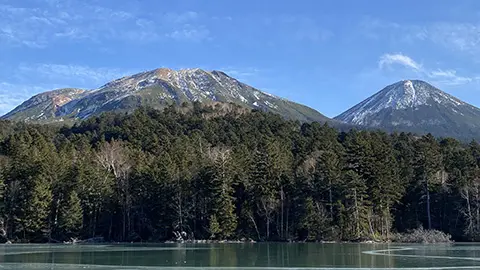VOL.192 MAY 2024
JAPAN’S HEALING FORESTS (PART 1)
Why do People Relax when they Go to the Forest?
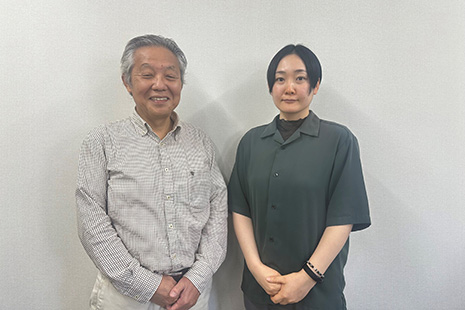
Many of us know from experience that going to the forest is relaxing. However, few people know why. One person who does is Miyazaki Yoshifumi, Emeritus Professor at Chiba University and Doctor of Medicine. He is a world-renowned authority on forest medicine and an advocate of forest therapy, which is defined as forest bathing supported by scientific evidence. We asked him about the relaxing and preventative medical effects of forest bathing.
—Could you explain what forest bathing is?
Forest bathing is the practice of going to the forest, synchronizing with it, and experiencing comfort. People feel comfortable in a certain environment when their own rhythm is in sync with it.
People experience a sense of comfort in the forest because of the long history human beings have with nature. Humans emerged six to seven million years ago, but most people have lived in urban environments only in the 200 to 300 years since the Industrial Revolution, a period that represents less than 0.01% of human evolution. In other words, humans have spent more than 99.99% of their evolution in the natural environment. Since our genetic makeup does not change in the short period of several hundred years, we are physically adapted to life in the natural environment. In contemporary society, however, we live in a state of constant hyper-vigilance, stress, and susceptibility to disease.
So, because we humans evolved in the natural environment and are built to interact with and adapt to nature, we feel relaxed when we are in contact with it. This theory of mine has been named the “back-to-nature” theory by New Zealand researchers M. A. O’Grady and L. Meinecke.
Incidentally, the term “shinrin-yoku” (forest bathing) was coined in 1982 by Akiyama Tomohide, then Director General of the Forestry Agency. His goal was to enhance the value of Japan’s forests by encouraging more people to visit them for relaxation. Then, in 1988, at the age of 34, I started my research on forest bathing to try to solve a question that had fascinated me since childhood: why do people relax when they come into contact with nature?
—What kind of experiments have you done in your research on forest bathing?
Our research team conducted various experiments to find out how people’s stress levels change in forest and urban environments, and scientifically explained the relaxing effects of forests.
In 1990, we conducted an experiment on Yakushima Island that became the world’s first physiological experiment on forest bathing. In it, we analyzed the concentration of cortisol, a type of stress hormone, in saliva using the latest technology available at the time.
In addition, as part of the Forest Therapy Base Scheme launched in 2005, we conducted experiments in cooperation with local governments and companies throughout Japan, with the participation of 756 subjects at 63 forest and urban sites across the country. The purpose of the Forest Therapy Base Scheme was to accumulate scientific evidence on forest bathing and to help revitalize local communities by enhancing the value of forests. Our team was responsible for a large-scale experimental project designed to accumulate evidence. We conducted field experiments in forest and urban environments, spending four to six days and involving about 50 people at each site, including research team members, subjects, and local government staff. We also conducted indoor experiments on the physiological effects of visual, olfactory and auditory factors. The scale of this project, which involved experiments at 63 sites, was unprecedented globally, and I believe it helped Japan become a world leader in forest bathing research.
—What kind of evidence did you obtain in these experiments?
In 2003, I proposed the concept of forest therapy, which means forest bathing backed by scientific evidence. Through the experiments carried out as part of the Forest Therapy Base Scheme through 2018, we identified the following changes that occur in the human body in a forest environment, and were able to determine that spending time in the forest has a relaxing effect.
- A decrease in sympathetic nervous activity (which is known to increase during times of stress)
- An increase in parasympathetic nervous activity (which is known to increase during relaxation)
- A decrease in pulse rate
- A decrease in blood pressure
- A decease in the concentration of the stress hormone cortisol (Fig. 1)
- Calming of prefrontal cortex activity
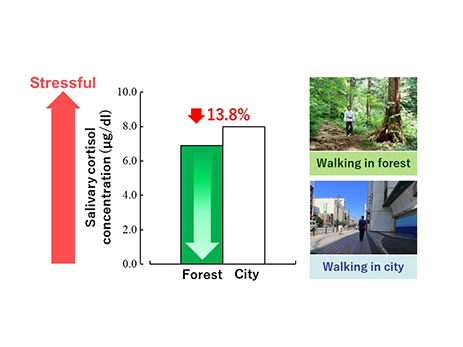
Mean of 348 males in their 20s (34 sites), forest vs. urban environments: statistically significant difference
Modified from original data in H. Kobayashi, Y. Miyazaki et al., International Journal of Environmental Research and Public Health 14:931, 2017
We also conducted forest therapy program experiments in the Akasawa Natural Recreation Forest, Nagano Prefecture, and Chizu Town, Tottori Prefecture. The programs included activities such as strolling in the forest, meditation, deep breathing, blind walking, and “throwing” stress and anxieties at waterfalls to wash them away. The experiments produced some interesting data. We found that these activities had a sustained effect on lowering blood pressure in people with hypertension. The results showed that blood pressure not only decreased after forest therapy, but also remained at normal levels three to five days after the subjects returned to work.
We also found that forest bathing helps regulate physiological functions. An experiment in which 92 subjects took a 15-minute walk in a forest resulted not only in a decrease in blood pressure in subjects with hypertension, but also in an increase in blood pressure in subjects with hypotension (Fig. 2). Similar effects were not observed when the same subjects walked for 15 minutes in an urban environment. We called the effect of forest bathing in bringing blood pressure to normal levels a “physiological adjustment effect.”
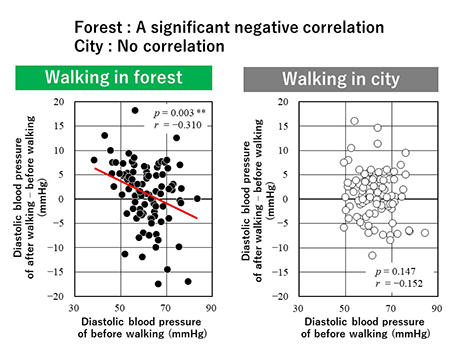
92 males in their 20s, forest walking: statistically significant negative correlation
Modified from original data in C. Song, Y. Miyazaki et al. International Journal of Environmental Research and Public Health 12:4247-4255 2015
Our research team provided scientific evidence to show that while forest therapy cannot cure diseases, it can be used to make the body more resistant to disease. This preventative medical effect of forest therapy is expected to contribute to the reduction of medical costs (Fig. 3).

Modified from original data in Y. Miyazaki. Shinrin-yoku: The Japanese Way of Forest Bathing for Health and Relaxation; Hachette UK Company, Octopus Publishing Group: London, 2018
—As a doctor of medicine, why do you study both nature and people?
Forest therapy focuses on studying the effects of nature on people, but there is no system in Japan, Europe or the United States that studies and provides education with regard to both nature and people. I did not set out to become a human and forest researcher. However, as a result of my experience as a student at the Faculty of Agriculture, Tokyo University of Agriculture and Technology, and my work as an assistant at the Faculty of Medicine, Tokyo Medical and Dental University, I was able to build a network in the fields of agricultural science and medicine, or in other words, nature and human research. In the past, the director of the Center for Health and Global Environment at the Harvard School of Public Health in the United States and the director of the Finnish Forest Research Institute have asked me for advice on how to implement research in an integrated manner with medical schools.
The integration of nature research and human research is in transition, and I believe that such integration of various fields, not only forest therapy, will become more important in the future.
—Which forests would you recommend to overseas visitors?
Certification of forests under the Forest Therapy Base Scheme is based not only on scientific evidence produced by our research team, but also on the services that each region can provide, specifically hard infrastructure, such as lodging, hospitals, and accessible roads, and soft infrastructure or experiential activities, such as soba noodle-making and woodworking, box lunches and meals. Certified forests offer sample courses for day trips and overnight trips.
My first recommendation is the Akasawa Natural Recreational Forest in Nagano Prefecture. It is considered the birthplace of forest bathing in Japan and offers a very high level of forest therapy activities. In the spring and fall, the Akasawa Natural Recreation Forest holds special forest bathing events. It also provides programs for visitors to enjoy with their children, such as forest railway rides and playing in the river.
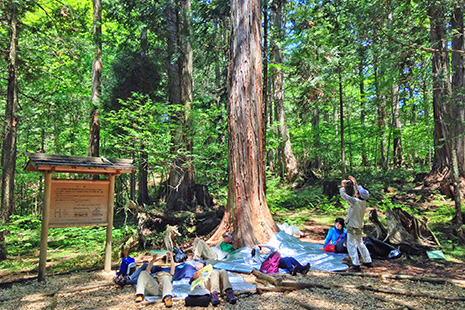
Photo: Agematsu Town Tourism Association
I would also recommend Okutama Town in Tokyo because it is known as the area with the largest number of giant trees in Japan and is easily accessible from the Tokyo metropolitan area.
Chizu Town in Tottori Prefecture has also developed a high-quality forest therapy program, which has been adopted as part of corporate training programs.
Tsubetsu Town in Hokkaido also offers various programs that take advantage of the changing seasons, such as snowshoe hiking experiences* and stargazing programs.**
Japan is one of the most forested countries in the world. When visiting Japan, be sure to enjoy the relaxing effects of the beautiful nature as well as the unique aspects of Japanese culture born from the natural environment in each region.
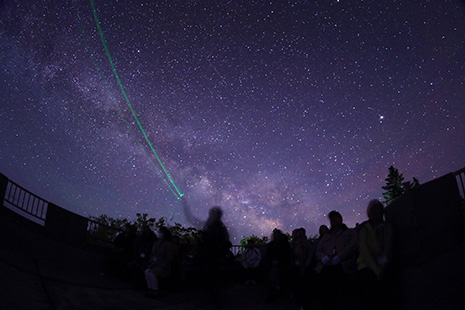
Photo: Nonno-no-mori Nature Center
* Forest therapy program in which participants hike on snowshoes through snow-covered mountains
** Forest therapy program for stargazing in the forest
By Kawamura Yusuke
Photo: Agematsu Town Tourism Association; Nonno-no-mori Nature Center
